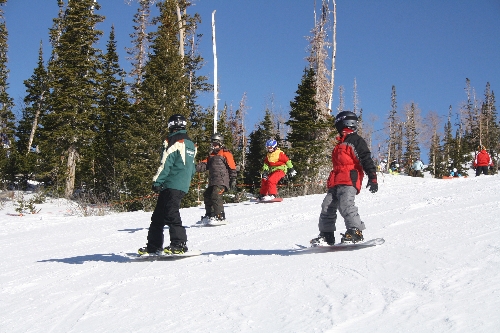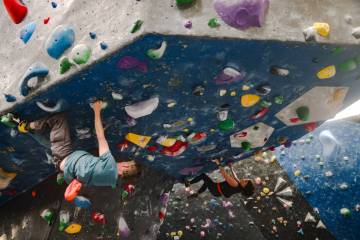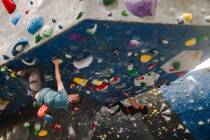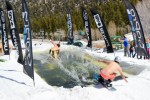Brian Head: Utah’s famous snow just three hours away
If you are looking for what many call "The Greatest Snow on Earth" and want plenty of ways to enjoy it, then Brian Head, Utah, is an ideal choice.
About a three-hour drive from Las Vegas, it is the highest resort town in the United States. The elevation brings copious amounts of annual snowfall, averaging 400 inches, practically guaranteeing many great ski days in a season that runs well into April.
There also are plenty of prospects for off-the-slopes activities as well, such as cross-country skiing and snowshoeing, in the surrounding public lands of Dixie National Forest and Cedar Breaks National Monument.
My daughter and I took advantage of a few days off on two occasions earlier this year to spend a few days at Brian Head. Our main reasons were to hit the downhill slopes, but on one of our visits, we wanted to do some winter sightseeing by skiing cross country, primarily in Cedar Breaks National Monument.
The resort's base elevation is a lofty 9,600 feet. Thanks to the high elevations and arid climate with low relative humidity, the snow has less moisture than at ski areas in the eastern United States, making it fluffy and light, perfect for skiing and snowboarding.
By some standards this is a small resort, but you will find plenty of varied terrain on 640 skiable acres, including 60 runs, several terrain parks and eight lifts. In the surrounding Dixie National Forest lands and Cedar Breaks National Monument, there are hundreds of miles of additional terrain for snowshoeing, cross-country skiing and snowmobiling.
We left Las Vegas early and arrived at Brian Head's Giant Steps Lodge by 11 a.m. After getting our lift tickets, we headed up the Giant Steps lift, the longest at the resort, and rode 4,840 feet to the top. We were blessed that day with wonderful warm and sunny weather and skied until we could hardly stand.
Then we hobbled over to our accommodations at the newly upgraded Cedar Breaks Lodge. The Lodge's rooming choices range from junior villas, which can sleep as many as four people, up to two-bedroom villas that can accommodate eight. They are all equipped with gas fireplaces and just about every amenity anybody who is not a spoiled rock star could desire. For example, all have either fully equipped kitchenettes or full-sized kitchens.
The lodge has an indoor swimming pool, two hot tubs and a sauna. It also has three restaurants: the Double Black Diamond Steak House, the Cedar Breaks Bar and Grill, and the Cedar Breaks Cafe.
The food at the lodge is some of the best around. We ate at the Double Black Diamond Steak House, which thanks to chef Angelo La Pietro makes everything from scratch from the freshest ingredients available. While there are many interesting and delicious meat items, he also offers vegan and vegetarian fare. Our meal was one of the best we have had in ages.
On our earlier trip to Brian Head, we stayed at the Grand Lodge, Brian Head's newest hotel. It offers both rooms and suites, but a standard room was all we needed. Even the standard room had all the amenities of a good modern hotel, including a refrigerator, microwave and even an iPod docking system. Our particular room also had a mountain view. Every guest has access to the hotel's other luxuries -- an indoor swimming pool, indoor hot tubs and two places to dine -- that are much appreciated after a winter day outdoors.
Brian Head resort comprises two mountains, Navajo Peak and Brian Head Peak, each with its own full-service base facility. Formerly, you needed to drive or take a shuttle between the two, but in 2007, after many years of talking about it, they added the Interconnect System.
Thanks to two new chairlifts, named Wildflower and Aspen Glow, as well as a ski bridge over the main road through town, you can now go back and forth between the two mountains. This also opened up 35 percent more skiable terrain at the resort.
The Brian Head Resort started small, opening in 1964 with one chairlift and a T-bar (the kind of rope tow that was common at early and startup ski areas) on the hill by Georg's ski shop.
The shop is named for Georg Hartlmaier, one of the area's first three permanent residents, the other two being his wife, Stephanie, and their son, Georg Jr. They hailed from Germany. George became Brian Head's first mountain manager and also served as the ski school director for the first seven years. Stephanie began selling her homemade sweaters, and Georg's ski shop was born. Now, more than 45 years later, the family still runs and operates that shop.
On our first visit this year, we talked with Georg Jr. while outfitting ourselves for a cross-country side trip. Besides the high-quality downhill skiing and snowboarding equipment you'd expect in a resort pro shop, they also rent cross-country skis.
"Our cross-country ski section is a growing market," Georg told me. He said people have discovered that sightseeing also can be a winter activity, when Cedar Breaks is accessible only via snowshoes, skis or snowmobiles. Once the heavy snow hits the park's main road, usually in mid-November, it is no longer plowed and becomes the ideal place for an excursion on skis or snowshoes, often skiable well into May.
After getting fitted for boots and proper-length skis, we met up with Georg Jr's. wife, Tatiana, who volunteered to be our guide for our morning outing. Besides being extremely knowledgeable on the area's cross-country trails, Tatiana has a lifetime of cross-country skiing experience. She grew up in Moscow, where the sport was part of her elementary school's physical education program.
We drove three miles south of town to the trail head, a small plowed parking area at the junction of Cedar Breaks Scenic Drive and Utah Highway 148. Judging from the road sign, its top barely visible above the snow surface, I estimated the snow depth was more than six feet.
As we set out on skis along the main route, we saw four people on snowshoes, breaking their own trail into the subalpine fir forest. Our first goal on this excursion was to visit the park service's yurt -- an American adaptation of the Mongolian nomad's circular framed tent, which serves here as a visitor center. The yurt was easy to find, only about a mile from the trail head. It is round and I estimate it to be about 20 feet in diameter. It was heated by a small wood stove, and the temperature displayed on a wall thermometer was a toasty 75 degrees. It had a small couch and a few chairs, and two large windows let in plenty of light.
Weather permitting, the yurt is staffed by volunteers on weekends, from 11 a.m. to 3 p.m. It is, of course, a great place to get information about the park. And it also proved a great place to warm up with a cup of hot chocolate before we headed back outside.
We skied farther into the park to visit the natural amphitheater that gives Cedar Breaks its name. Tatiana brought us to the rim, where we had a classic view into the park. Stretched out in front and below us was a 2,000-foot-deep natural amphitheater. Its limestone deposits have weathered into hoodoos, arches, fins and columns in a multitude of colors, which glowed even more intensely when contrasted against the surrounding snow and brilliantly lit by its reflected light.
The amphitheater was formed over millions of years and is still changing, largely through erosion. Some erosion is of the usual sort, when flowing water from rain or melting snow carries away loose limestone and sand. But there's also a natural process called frost wedging. Water is deposited in cracks of the rock, then freezes and thus expands the crack. At some times of year, there's a freeze every night and a refill every day from melting ice and snow, so this kind of erosion is pretty fast as geology goes.
The vibrant colors of the canyon come from oxidized minerals; iron results in the orange and red tones, and manganese gives us the purple.
After our excursion to Cedar Breaks, we switched our Nordic equipment for downhill skis and headed up the newest ski lift near the ski bridge. From the top of this lift, we headed down to one of the resort's several terrain parks, this one called The Junkyard. This park is for more advanced board riders and skiers, and its joys include at least four jumps, two up rails, a down rail and whimsical obstacles to negotiate, such as a partially buried automobile.
On our way back to the hotel, we stopped over at the base of the Navajo Peak area to check out Brian Head's Snow Tubing Park. This is a pretty organized and safe activity here, compared with other venues where people tube, almost out of control, at risk of colliding with trees, rocks, elk and each other. Here, there are six groomed lanes and it's just one person to a tube, on each lane. While these safety measures remove the excitement of flying downhill willy-nilly with as many people as you can fit on a tube, plenty of fun remains.
Furthermore, it's a less taxing activity here, for the park has eliminated the drudgery of hauling your tube behind you as you trudge back up the hill. There's a surface lift that takes you and your tube back up the slope.
In less than 50 years, Brian Head has grown from an obscure backcountry mountain to a nationally known ski mecca, famed for reliable snow and friendliness to families. Now you have a choice of two luxury hotels as well as other assorted condo and room rentals, ranging from the modestly priced to damn-the-expense.
As a lifelong skier I appreciate all those new lodging options and amenities. But nothing will ever exceed my appreciation for Brian Head's central feature: 400 inches of dry snow, nearly every year, only half a day from my home.
IF YOU GO
Location: Brian Head, about 196 miles from Las Vegas in southwestern Utah
Directions: From Las Vegas, take Interstate 15 north 180 miles to Exit 75, at Parowan, Utah. Take Utah Route 143 for 16 miles to Brian Head.
Lodging: Cedar Breaks Lodge, 223 Hunter Ridge Road. (435) 677-3000. Grand Lodge at Brian Head, 314 Hunter Ridge Drive. (435) 677-9000, www.grandlodgebrianhead.com. Also, Georg's Ski Shop handles a variety of rentals from condos to homes. (435) 677-2013, www.georgsskishop.com.
Transportation in Brian Head: Complimentary shuttles throughout town
Brian Head Ski Resort: Lifts are open daily 9:30 a.m.-4:30 p.m., Mountain Standard Time. Resort ticket offices and base lodges open at 9 a.m. daily. A full-day adult ticket on nonholidays is $49, full-day child/senior ticket is $35. Children younger than 5 enter free with paying adult. Half-day, multiday, night and group tickets also available. (866) 930-1010, www.brianhead.com.
Adult Winter Sports School: Learn-to-ski and snowboard programs are offered for guests ages 13 and older at any ability level. (866) 930-1010.
Kids Camp at the Navajo Lodge Learning Center: Wee Ski (age 3), Tiny Tracks (ages 4-5) and Mountain Explorers (ages 6-12 for skiing and 7-12 for snowboarding). Coaching, lunch, equipment, all-day supervision and lift tickets offered. Advance reservations needed for Wee Ski. (866) 930-1010.
Snow tubing: Surface lift starts near Navajo Lodge Learning Center Area. Two-hour sessions are $15 and include tube and lift. Open daily. (866) 930-1010.
Brian Head Ski and Snowboard Equipment Rentals: Available at Giant Steps Lodge or Navajo Lodge Learning Center. Ski packages are $25 per day for adults, $16 per day for children. Snowboard packages are $30 per day for adults and $25 per day for children.
Georg's Ski Shop ski and snowboard rentals: 612 S. Highway 143. Ski and snowboard packages. Ski parkas and pants available for rent. (435) 677-2013. www.georgsskishop.com.
Cedar Breaks National Monument: Winter access is only by cross-country skiing, snowshoeing or snowmobiles. Yurt is open for day use only when staffed on weekends, weather permitting. (435) 586-0787, www.nps.gov/cebr/
Dixie National Forest: (435) 865-3700, www.fs.fed.us/dxnf/























